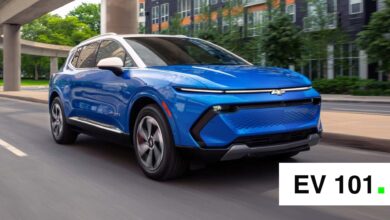No Charging Stations and 4 More Ways Owning an EV Costs More Than You Think

The era of electric vehicles (EVs) promised a cleaner, cheaper driving experience. EVs don’t burn expensive gas or pollute the environment with harmful emissions. Far fewer moving parts mean less frequent breakdowns and only rare trips to the mechanic. With the power to plug in at home, drivers can reduce their costs even further by charging their batteries when electricity rates are cheapest.
At least in concept.
Find Out: 8 Hybrid Cars That Lose Their Value the Fastest
Read Next: How To Get $340 Per Year in Cash Back on Gas and Other Things You Already Buy
As EVs creep further into the mainstream with each passing year, drivers have seen more and more flaws in the financial arguments for investing in one. Here are some of the ways that owning a zero-emissions vehicle can cost you more than you might think.
Too Few Stations Force Drivers To Recharge Where and When They Can — Not Where and When They Want
President Biden signed a bipartisan infrastructure bill into law in 2021 that included a $5 billion National Electric Vehicle Infrastructure program tasked with building 500,000 public charging stations by 2030. In March, the AP reported that just a handful of stations have been built in only four states.
On top of that, almost 21,000 of America’s roughly 33,000 existing public fast chargers are Tesla Superchargers, which are compatible only with cars produced by Elon Musk.
That leaves many of the country’s EV owners — particularly those with non-Teslas — suffering from range anxiety, especially in less-populated swaths of rural America.
This can be as expensive as it is frustrating.
According to Electronic Office Systems, time-of-use pricing incentivizes charging during off-peak hours when demand on the grid is lower. However, drivers in regions with too few stations don’t have that luxury and are often forced to recharge during peak hours when electricity is most expensive.
Check Out: 10 Affordable Compact Cars That Will Last 300,000 Miles
Generally, EVs Still Have Much Higher MSRPs
A handful of relatively inexpensive sub-$35,000 EVs have entered the market, and a $7,500 federal tax credit eases the burden for the specific models that meet strict qualifying standards — but by and large, EVs come with sticker shock.
“Upfront, the price of EVs can be several thousand dollars more than a comparable gas-powered model,” said Todd Bialaszewski, a certified master mechanic with over 15 years of experience and the founder of Junk Car Medics.
Many thousands, actually.
According to Edmunds, there was a 42% gap in the price of EVs and gas cars in the first quarter of 2024. The gap widened to 58.5% in the popular compact SUV category, where the average EV costs $53,048 — $17,326 more than $35,722 for the average gas-fueled compact crossover.
You Have To Pay To Save Money on Home Charging
Charging overnight at home is almost always the cheapest option, but the residential infrastructure that makes it possible can cost enough to negate fuel savings for years to come.
“Installing a Level 2 home charger costs $1,000 to over $4,500, depending on the work required,” Bialaszewski said. “That’s money that needs to be budgeted before any fuel savings are seen.”
According to EV Charging Summit, “The national average cost for EV charging station installation is between $1,000 and $2,500.”
Replacing Dead Batteries Can Cost More Than a New Car
Car and Driver reports that all automakers currently provide at least an eight-year, 100,000-mile warranty on their EV batteries. After that, you’re on your own — and when the inevitable happens, expect to dig deep to get your electric car electrified again.
“The batteries that give EVs their long ranges have life span issues that consumers may not realize,” Bialaszewski said. “Over time, batteries will hold less of a charge, losing miles of driving ability. Replacing degraded battery packs can easily exceed $5,000. During a routine maintenance visit, one of my customers was surprised to learn her four-year-old EV needed a new battery pack that would cost over $8,000 to replace due to degraded performance.”
According to Recurrent, “Electric car battery replacement costs outside of warranty can range from $6,500 to $20,000.”
They’re Expensive To Repair, Which Makes Them Expensive To Insure
When all is said and done, EVs are both more expensive to buy and — at least for the first 10 years — more expensive to own.
According to Self Financial, “The average annual cost to run an electric vehicle in the USA is $4,856, compared to $4,107 for a gas car, including insurance, taxes, gas, charging and maintenance.”
One of those factors weighs heavier than all the rest.
“EVs are more expensive to insure than traditional vehicles,” said Melanie Musson, an auto industry expert with AutoInsurance.org.
“In previous years, electric vehicles were cheaper to run in every state, however, the average insurance for an EV has increased by 58.1% from 2021 to 2023, while insurance for gas cars has only increased by 1.2% in this period,” according to Self Financial.
So why have EV premiums gotten so expensive so quickly?
“Their higher value tends to mean higher insurance premiums,” Musson said.
There’s also a factor uncovered by research from EV collision data firm Mitchell — EV repairs require nearly 90% original automaker parts compared with about two-thirds for ICE models.
“They have a higher risk of costly damage following a minor crash,” Musson said. “If something happens to the battery, that repair or replacement alone can cost $10,000 or more.”
More From GOBankingRates
This article originally appeared on GOBankingRates.com: No Charging Stations and 4 More Ways Owning an EV Costs More Than You Think



